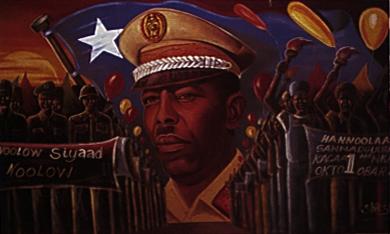During the 1980’s the Somali economy
took a turn for the worse. Stiff competition for the Saudi Arabian
market cut heavily into what had once been a Somali monopoly. Saudi
Arabia had accounted for over 90 percentof Somali exports.
In addition, severe drought throughout the decade took its toll on the
Somali livestock, which represented more than 80 percent of the goods that
Somalia exported
(21). The poor economy
created difficult times and lowered morale throughout the country.
July 14, 1989 marked the beginning of the
end of Siad Barre’s regime. On this hot summer Friday afternoon in
Somalia’s capital, Mogadishu, Barre’s troops fired at Islamic worshippers
as they left the city’s mosques. The troops regarded the worshippers
as demonstrators. Hundreds were killed and the violence continued
in the days that followed (22). Most
of those killed were members of the Issaq clan, who were picked out because
of their clan origin. The violence quickly spread into the countryside.
In early 1990, the Washington Post reported:
“The 20-year rule of Somali leader Mohammed Siad Barre appears
to be crumbling… The octogenarian ruler is unable to control the nation’s
armed forces, which are accused of committing recent mass murders of civilians
in central Somalia and numerous acts of banditry, looting, and harassment…
The Presidential Guards are the prime suspects in increasing numbers of
rapes and robberies of civilians and foreign aid warehouses” (23).
By mid-1990 the civil unrest in Mogadishu had
increased significantly as armed, clan-based opposition to Barre began
to coordinate their efforts. On July 6, an anti-Barre demonstration
deteriorated into a riot in which the Red Berets opened fire on the protesters,
killing at least 65 of them
(24). Barre
soon became a prisoner in his own compound, located in the center of Mogadishu.
By this time, he had control over only a small section of the city.
Barre’s army had collapsed into clan-based factions, with only the Marehan
clan soldiers remaining loyal to the president (25).
On January 27, 1991, Barre left Mogadishu
in a military convoy, returning to the land of his kinsmen for safety (26).
Thus, the dictatorship of Siad Barre came to end and Somalia was left in
a state of anarchy. |
